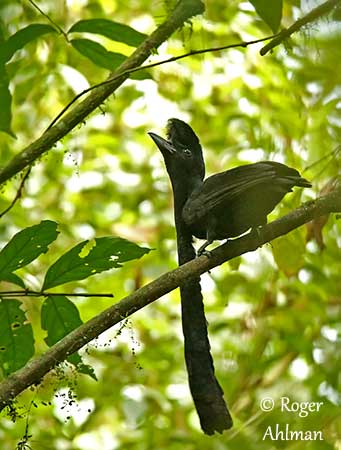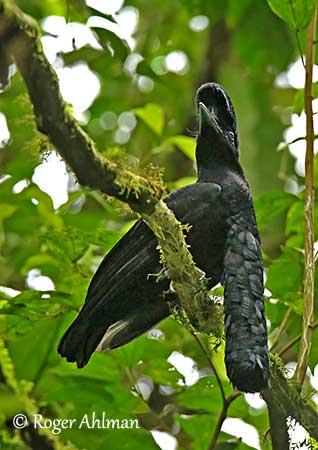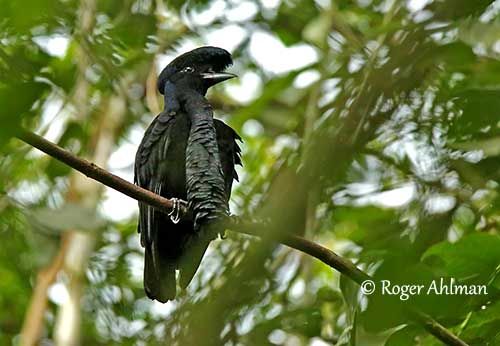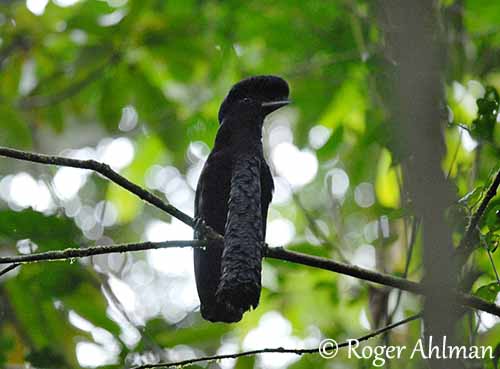
Fr : Coracine casquée
Ang : Long-wattled Umbrellabird
All : Langlappen-Schirmvogel
Esp : Paragüero Corbatudo
Esp Colombia : Toropisco del Pacífico
Esp Ecuador : Pájaro-paraguas longuipéndulo
Ita : Uccello parasole caruncolato
Nd : Ecuadoraanse Parasolvogel
Sd : Pendelparasollfågel
Photographers:
Roger Ahlman
Pbase Galleries Peru and Ecuador
Didier Buysse
Vision d’Oiseaux
Text by Nicole Bouglouan
Sources:
HANDBOOK OF THE BIRDS OF THE WORLD Vol 9 - by Josep del Hoyo - Andrew Elliot - David Christie - Lynx Edicions - ISBN: 8487334695
A GUIDE TO THE BIRDS OF COLOMBIA by Steven L. Hilty and William L. Brown - Princeton University Press – ISBN 069108372X
BIRDS OF SOUTH AMERICA – Passerines - by Robert S. Ridgely and Guy Tudor – HELM Field Guides – ISBN: 9781408113424
L’ENCYCLOPEDIE MONDIALE DES OISEAUX - Dr Christopher M. Perrins - BORDAS - ISBN: 2040185607
BirdLife International (BirdLife International)
Neotropical Birds – Cornell Lab of Ornithology
Wikipedia, the free encyclopaedia
Home page
Page Passeriformes Order
Long-wattled Umbrellabird
Cephalopterus penduliger
Passeriformes Order – Cotingidae Family
INTRODUCTION:
The Long-wattled Umbrellabird is a strange bird and the largest passerine of the Americas. The male carries a long black wattle, and the large crest resembles an umbrella, both giving the bird its name. These ornaments are enhanced by displays during the breeding season. The smaller female lacks the long wattle and is fairly similar to a Raven.
Due to habitat loss, hunting and pet-trade, the populations are declining and the species is classified as Vulnerable.
DESCRIPTION OF THE BIRD:
Biometrics:
Length: M: 40-42 cm – F: 36-37 cm
Wattle length: 28-35 cm
The adult male has black plumage overall, with bluish gloss on head, upperparts and wattle. The belly is duller black.
On the head, the black, umbrella-like crest can cover almost whole of the bill. However, it is laid back in flight.
The long wattle is well feathered on the sides, and mostly flattened on the back side. This ornament hangs from the lower throat and may reach up to 35 centimetres in length. In flight, it is retracted and held close to the breast.
The powerful two-tone bill has black upper mandible and pale grey to pale blue lower mandible. The eyes are dark brown. Legs and feet are blackish.

The female resembles male but she is smaller, with smaller wattle or almost absent. The crest is shorter too.
The juvenile resembles female with duller black plumage and greatly reduced ornaments.
RANGE:
The Long-wattled Umbrellabird is found in a fairly narrow area along the Pacific slopes of the Andes in SW Colombia (Chocó) and W Ecuador (S to El Oro).
HABITAT:
The Long-wattled Umbrellabird frequents foothills and humid montane forest on the slopes of the Andes, forest borders and isolated trees in clearings.
The species is visible between 150 and 1800 metres of elevation.
CALLS AND SONGS: SOUNDS BY XENO-CANTO
The Long-wattled Umbrellabird is usually silent except during the displays. Several males (5-6 or more) gather at leks where they display. While jumping from branch to branch, they utter low-pitched, far-carrying booming calls and prolonged grunts “boooh” or “wooom”, audible for 400 metres and uttered at intervals of 20-60 seconds.
The female may produce some “aaugh” call, probably when alarmed.
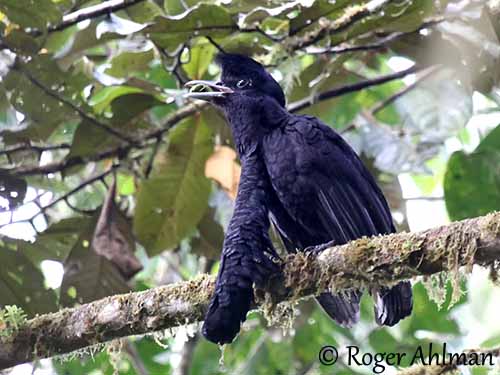
BEHAVIOUR IN THE WILD:
The Long-wattled Umbrellabird feeds on fruit and insects, and occasionally takes small vertebrates. It usually feeds on berries, palm fruits and nuts, and regurgitates the larger seeds of some fruits, taking part in the regeneration of the tropical forest.
It also catches insects and larvae, and some spiders too. This type of food is mainly taken during the rainy season, when the fruits resources are scarce. Some vertebrates such as small birds, frogs and lizards are sometimes caught.
It takes the fruits while perched, but in case of spiny palms (Bactris), the food is plucked while the bird is hovering. The larger insects are often beaten against a branch before to be swallowed.
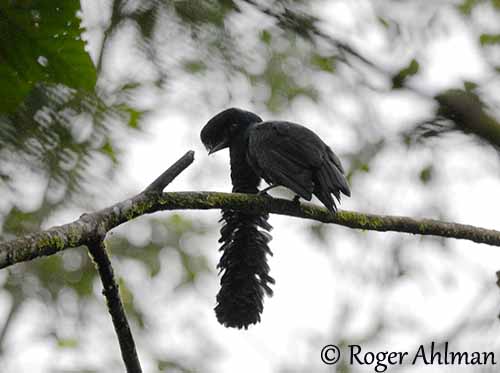
The Long-wattled Umbrellabird is resident in its range and mainly sedentary although some altitudinal movements may occur from high-altitude forests into adjacent lowlands.
The strong and undulating flight is performed with slow wingbeats. During the flight, the crest is flattened and the wattle is shortened and held against the breast.
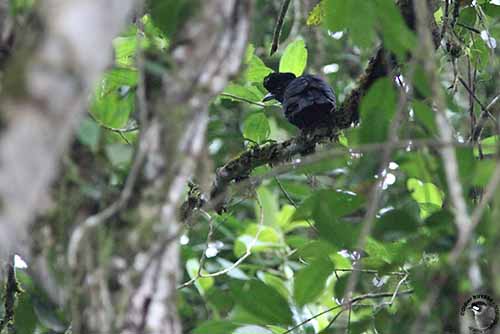
PROTECTION / THREATS / STATUS:
The Long-wattled Umbrellabird is threatened by hunting pressure. The males are killed at leks where they are conspicuous while displaying.
Habitat loss through deforestation for road network, agriculture and gold mining affect some protected areas. Agriculture expansion and livestock-farming are major threats. In addition, this species suffers from illegal pet-trade.
The population is declining and its size is estimated at about 6,000/15,000 mature individuals.
The species is currently classified as Vulnerable.
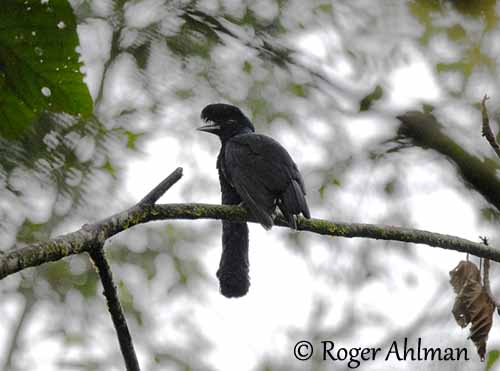
REPRODUCTION OF THIS SPECIES:
The courtship displays usually occurs between August and December during the dry season, when the fruit resources are abundant. The males feed on fruits to gain energy for displaying. However, the peak of nesting activity by female occurs six months later, during the rainy season, when insects are abundant, because she feeds her chick with invertebrates.
The male does not take part in nesting duties.
The female builds the nest, a loose platform placed high in tree fork, about 5 metres above the ground, usually in tree fern. It is made with twigs, and lined with softer materials such as thinner twigs, roots and mosses.
She lays a single egg and incubates during 27-28 days. The chick is covered with cream-coloured down. It is fed by the female alone and fledges about one month after hatching.
